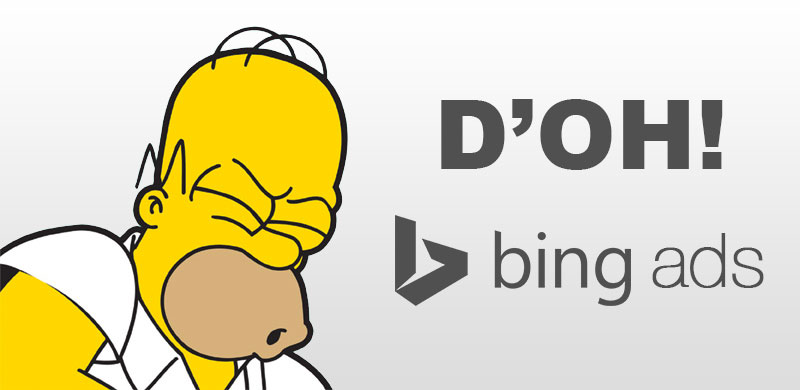
HELLO BING PRODUCT ADS…I HOPE YOUR LISTENING!
If you’ve ever had the pleasure of working with shopping engines and shopping feeds then what your about to read may surprise you a bit as it doesn’t make much sense. We received an email yesterday from Bing Product Ads support stating that starting June 25, 2014 Bing Product Ads would be enforcing new policies to ensure the quality of the Bing Shopping experience. That is all well and good, but one of these new policies makes no sense!
To help you safeguard [the Product Ad] experience, we’re instituting new checks that compare your Product Ads with the information on your landing pages. If our system finds inconsistencies between the two, the affected offers will be rejected and will stop displaying. These new checks are:
- Item price: The price must be the same in your product feed as it is on your landing page.
- Item title: The title must be the same in your product feed as it is on your landing page.
- Links: Your landing page link and all the links on your landing page must work.
Checking to make sure the Item Price matches the landing page makes perfect sense. Validating that the Links work makes perfect sense. However making sure the Item Title matches that landing page does not and here’s why.
Example #1 – Apparel Websites
Let’s say you sell footwear or any apparel products. On a typical ecommerce website the product shown will be the parent product, with options for sizes or colors. In this example we will use footwear and sizes.
Landing Page Title:
Caterpillar Men’s 6 Inch Honey Second Shift Steel Toe Boot
Here’s the issue, this product happens to come in sizes ranging from 7-14 for men and 6-12 for women. That means there are 15 variations of this one product. To separate these 15 products in the feed, one would typically amend the title with the size and gender so your titles would look something like this:
Caterpillar Men’s 6 Inch Honey Second Shift Steel Toe Boot – Mens Size 7
Caterpillar Men’s 6 Inch Honey Second Shift Steel Toe Boot – Mens Size 9.5
Caterpillar Men’s 6 Inch Honey Second Shift Steel Toe Boot – Mens Size 11
Caterpillar Men’s 6 Inch Honey Second Shift Steel Toe Boot – Womens Size 6
Caterpillar Men’s 6 Inch Honey Second Shift Steel Toe Boot – Womens Size 9
Now according to Bing’s new rules all of these products would be omitted from being seen in Bing’s Product Ads, as the titles being submitted in the feed don’t match exactly what is being displayed on the landing page.
Example #2 – Similar Products from different brands
Lets say you sell wire and cables, and many of your products have the identical title as the products are the same, but sold by different brands and sizes.
Landing Page Title:
12 AWG 2 Conductor Solid Bare Copper FPLP
In this example the website segments their products by brand and can have duplicate titles within the website. When we send these products to Bing Shopping or Google Shopping, we again amend the title to better reflect the product. Not only do we amend the brand name to these products, but they also come in different lengths. So again here are the examples of what is being submitted in the feed:
Comtran 12 AWG 2 Conductor Solid Bare Copper FPLP – 1000 ft
Comtran 12 AWG 2 Conductor Solid Bare Copper FPLP – 500 ft
Tappan 12 AWG 2 Conductor Solid Bare Copper FPLP – 1000 ft
Tappan 12 AWG 2 Conductor Solid Bare Copper FPLP – 500 ft
Now again, according to Bing’s new rules all of these products would be omitted from being seen in Bing’s Product Ads as the titles being submitted in the feed don’t match exactly what is being displayed on the landing page.
Example #3 – Improving Poor Title
In many cases ecommerce websites use the title provided to them by the manufacturers. These title can be very generic and lacking descriptions to make them more relevant in searches. In this example we have a client who sells Kitchenaid mixers.
Landing Page Title:
KitchenAid Artisan Stand Mixer
In case you’re unaware, these things come in a large variety of colors and models. In the past couple of years we noticed that many of the search queries contained the model number. So to help make these products more relevant we have amended the model numbers to the titles.
KitchenAid Artisan Stand Mixer – Almond Creme – KSM150PS
KitchenAid Artisan Stand Mixer – Aqua Sky – KSM150PS
KitchenAid Artisan Stand Mixer – Blue Willow – KSM150PS
KitchenAid Artisan Stand Mixer – Buttercup – KSM150PS
KitchenAid Artisan Stand Mixer – Candy Apple Red – KSM155GB
KitchenAid Artisan Stand Mixer – Electric Blue – KSM155GB
An Ecommerce Disaster
If Bing doesn’t rethink this, ecommerce sites who wish to advertise on Bing Product Ads may need to completely change how products are entered into their back-ends. And if you’re a Magento user, forget using configurable products, as every product will have to be entered as simple products. If you use platforms like Volusion, Big Commerce or 3dCart, forget about creating product options, you need to enter every product in as its own separate entity.
In summary, whomever made this decision at Bing Product Ads obviously has never actually worked with ecommerce sites, because if they had, this notion of matching the product titles in the feed exactly to the landing page make zero sense!
UPDATE: We have since heard from the Bing Product Ads Team about the “Item Title” issue. They are looking into the issue before releasing the new feature. See the comments below from Bing.







Let me start by thanking you for your feedback and help in identifying issues regarding our new policies to ensure quality of the Bing Shopping experience. The purpose of the outreach email (before actually implementing the feature) was precisely to garner issues like the ones mentioned in your blog post.
I am happy that you feel it makes perfect sense to validate “Item Price” and “Links” to the product page.
On the subject of title match, the data quality pipeline does not use an exact match. It attempts to match sub-strings, similar phrases and relevant variations. In the scenario presented in your blog, I agree that all three scenarios should have passed the quality check. The fact that it did not indicates that we need to tweak / re-train our algorithms a bit, which we are in the process of doing.
Bing will launch this feature only when all relevant issues are fixed.
Thank you once again for your feedback!
Regards,
Suneel Kaw
Product Manager Data Quality
Bing Product Ads
Hello Suneel,
Thank you for your timely response to the “Item Title” issue.
I now have a better understanding of how and why Bing is trying to implement this new title match feature, however the confusion may have been adverted had their been better documentation about the upcoming release. I spoke with several Bing Ads and Yahoo representatives, and no one was fully up to speed on this requirement. The most recent Bing Merchant Center Integration Guide, just released June 18th, also has no mention of this feature or how to correctly format titles to meet guidelines.
Besides the examples I have pointed out above, I’m sure there will be plenty of additional scenarios which will require Bing to do a lot of tweaking to the alogirthms. I’m glad I’m not tasked with that job.
I would like to thank Stephen, Julie & Mike at Bing Product Ads support for responding to my emails, as well as Mike over at Yahoo. Obvisouly the message got from them, to you and your team.
Best regards,
Greg Yevich
OperationROI